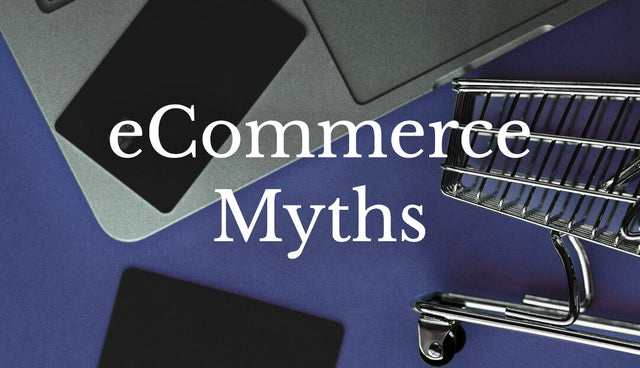Popular eCommerce Myths Busted!
Like any other industry nowadays, word-of-mouth tips and tricks for eCommerce often explode into the mainstream with just a couple of retweets or shares from sizeable social media accounts.
We’ve all seen or heard those rumours that fly around the eCommerce world, the ones that make you stop for a second and think ‘can that really be true?’ – but is it actually possible to make sense of these so-called eCommerce myths and unearth the truth behind the hearsay?
Well, with the guidance of Adobe and thoughts from the leaders of global organisations like LinkedIn, Ocado and Nando’s, we’re going to take a look at 5 of the most talked about eCommerce myths and try to show you which of them might be leading you astray…
Myth 1 – Personalisation
It’s already deeply ingrained in modern-day eCommerce, but the topic of personalisation and its impact on customer relationships is still up for debate.
Brands are usually keen to explain their core values and future plans for growth, but it’s rare for them to follow through with this when it comes down to the real nitty-gritty of day-to-day sales. It can sometimes feel like online stores are using personalisation as more of a sales gimmick, rather than a tool to make things genuinely easier and seamless for their customers.
A quick look at how brands build personalisation into their stores shows that it’s heavily reliant on third-party data – something known to be incredibly unreliable and inconsistent. The words ‘scary’ or even ‘creepy’ have been used by customers who describe the whole feeling of personalisation as perhaps that step too far into their personal data.
Personalisation is at its best when it goes unnoticed, so the best thing to do is offer context, value and simple straightforward interaction – we recommend using a platform like our partners Yotpo for this.
Conclusion – Legitimate, but only when done right.
Myth 2 – Email Marketing
Following on closely from personalisation is email marketing, something that has been around for a long time in several different guises, but is it still relevant today?
For the most part, yes. The challenges nowadays however are to respect the fact that the average customer receives a LOT of emails on a daily basis, so standing out from the crowd here is tougher than ever before. Getting email marketing right is a full-time job in itself these days so if you don’t have the right resources and approach, achieving success with your emails is very unlikely. We strongly recommend using our email marketing partners DotDigital.
Email as a platform is most powerful as part of an omnichannel approach to marketing, particularly as there are so many scenarios in which it can be useful. You also get to be incredibly creative with your content in a bid to be engaging and respected by your audience, thereby naturally building that all important brand loyalty over time. Just avoid the hard sell approach, something known to turn customers off and increase those unsubscribe rates.
Conclusion – Legitimate, if run correctly.
Myth 3 – Data
As technology continues to develop and evolve at a rapid pace, so does the online shopping experience for our customers. Data is how we monitor and track the success of our eCommerce store, the engagement of our audience and the patterns that show us what to do next – but is it more than that?
Relying on data alone can be harmful in some situations, particularly as we forget that it can be imperfect just like the humans that create it. Understanding and utilising data to your advantage is one thing, but being focused solely on data alone can be detrimental. It’s all about being able to recognise the patterns that emerge from the figures and remembering the fact that the numbers may represent individual customers, but there is still a need to drill down further into the more human aspects to really benefit from any data analysis.
Data is not just a ‘one and done’ scenario that you can complete and move on from. It is a constant, evolving report that needs ongoing attention and human decision-making alongside it. Machine learning is great and all, but your customers are people at the end of the day and they should be your sole focus. Take a look at our UX & CRO page for more information on this topic.
Conclusion – Busted! Data should be viewed as a guide, not a rule.
Myth 4 – Pricing
Often the be all and end all for customers, price is believed to reign supreme above every other factor in the highly competitive world of eCommerce. Cheaper isn’t always better though, as many will attest to.
The key thing to remember here is that whether or not something is perceived as being expensive doesn’t actually depend on how much it costs; it depends on what it’s being compared to.
It’s so easy to compare prices online for pretty much any product, but brands can offer so much more than just a good deal. Serving up the right content to your audience at the right time is key – customers won’t necessarily remember what you said or did, but they will remember how you made them feel. Connecting with your customer base on an emotional level through your content and website experience ultimately determines how that individual feels about your brand, forgetting price almost entirely. You can be more expensive than other stores and still enjoy success.
Conclusion – Busted! Price is no longer king.

Myth 5 – The High Street
In the wake of the coronavirus pandemic and its impact on economies all over the world, it’s clear to see why some believe the high street has finally been killed off.
Before COVID-19, it was reported that some retailers were only taking 20% of their revenue from eCommerce sites, with the remaining 80% coming from brick and mortar stores – this then jumped overnight to 100% as the pandemic hit, a huge culture shock for any business.
The impact of coronavirus for the high street should be seen more as an opportunity to reset rather than a signal to shut up shop. Customer expectations for online shopping are sky high and get reset with every click, so it’s important to remember what the high street store can provide that an online store cannot.
Going into a store now is all about the experience, the interaction and the emotions that come with it. Store shoppers can be significantly more impacted than those sat at home clicking through the same product range on their laptop, meaning brands can leverage this energy to build deeper relationships.
Conclusion – Busted! The high street lives on.




